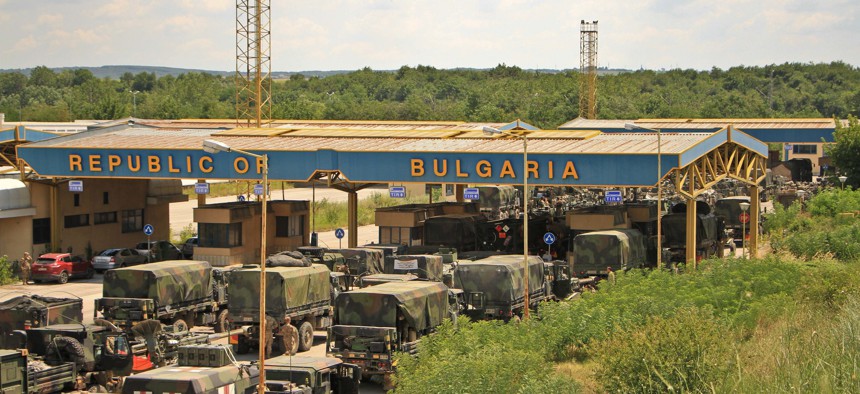
Task Force War Eagle under the command of 1st Squadron, 2d Cavalry Regiment crossed the border from Romania to Bulgaria July 18, 2017 for the Dragoon Guardian convoy to continue on for more Saber Guardian 17 exercises. U.S. Army Europe
If War with Russia Breaks Out, Borders and Bureaucracy Could Slow the West’s Response
In a summer of multinational exercises in Europe, the first thing the U.S. Army learned was: ‘Borders are hard.’
A 2,200-kilometer road trip across Europe with a Stryker brigade combat team takes a while. It takes even longer if the convoy sits, sweltering under the summer sun, waiting for paperwork to be stamped at border crossings both international and municipal.
That’s what happened when U.S. Army Col. Patrick Ellis led a group of armored vehicles from Germany through Hungary, Romania and Bulgaria and all the way across the Black Sea to Georgia this summer, participating in multinational exercises along the way. The first thing they learned was: “Borders are hard.”
“Sometimes the Ministry of Defense decides you’re coming, but the Ministry of Interior has its protocols at their border, because they run the borders, not the MOD,” Ellis, the commander of the Army’s 2nd Cavalry Regiment, told the crowd at a Defense One event earlier this week. “To get into Romania was pretty easy; to get out was, actually, surprisingly harder…Nobody was being unprofessional, but there’s just protocols they’ve got to follow, so we sat in our Strykers for an hour and a half in the sun just waiting for guys to manually stamp some paperwork.”
Crossing multiple international borders and countless municipal ones over the course of that trip, it’s not the worst thing that could have happened. Sure, Ellis said he’d “love to just roll through and have an E-ZPass light up, ‘Bing, Bulgaria,’ and drive on.” But the convoy was never denied entry, and Ellis said the 90 minutes at that Romanian border was the longest crossing they experienced.
But over the course of a couple thousand kilometers — 90 minutes here, another 30 there at the next province’s line — the stops add up. And in the event of a war with Russia, that’s how far some NATO member troops might have to travel to the fight. From Stuttgart, Germany, for instance, it’s more than 1,800 kilometers to Latvia’s Russian border.
In the last year, NATO has stood up four multinational battle groups in central and eastern Europe to strengthen the alliance’s deterrence posture; Ellis’s 2nd Cavalry Regiment makes up most of the U.S.-led group in Poland. But those Enhanced Forward Presence groups, with a little over a thousand personnel each, are sized for deterrence, not conflict.
And the Army says there’s little reason to think even a hypothetical act of Russian aggression against a NATO member would change the bureaucratic realities of transiting Europe.
“Even if war breaks out … it’s not ‘all rules are off,’” Maj. Gen. Steven Shapiro said at the same event. “It’s not going to be that.”
Not least because each country — even if their immediate contribution to the fight was minimal — would still have to be on board with the political decision to call the act of aggression an Article 5-level violation. (Though Ukraine isn’t a NATO nation, disinformation campaigns and the low-level of conflict muddled the alliance’s initial response to the invasion of Crimea.)
“If war breaks out, I would say to you, that depending on where the war is, we’re going to move U.S. forces, or German or Dutch or French forces somewhere, and the countries that they would have to pass through all have to be on board with war breaking out,” said Shapiro, the man responsible for the U.S. Army’s logistics and sustainment in Europe. “And everyone’s different, within their legislatures I think they would have to say, ‘This is a true declaration, and we go under these rules [for this amount of time].’”
It’s something that’s long concerned Lt. Gen. Ben Hodges, the commander of U.S. Army forces in Europe. He, along with allied defense ministers, have suggested a “military Schengen” — a rough equivalent of the open-border zone that allows European citizens to travel unrestrictedly across internal borders.
Related: Russia Has 100K Troops On the Move. Here’s Why NATO Can’t Do the Same
But there are steps European countries could take in the nearer term that wouldn’t be nearly as drastic. Standardizing paperwork, for one. Right now, preparation for a trip like the one Ellis’s Stryker group took this summer takes weeks, Shapiro said.
“I’ve got a team of people, where we’re saying, ‘Okay, how many vehicles in the convoy? It’s 100.’ And it’s not just 100 vehicles in a convoy, it’s these 100 vehicles by serial number. And then all of those are going to on a document,” he said. “Every border you cross, you’re listing those same 100 vehicles on a different kind of document. And then you cross an international border, and it’s those same 100 serial numbers on a different document in a different language before you get to where you’re going.”
Getting 30 or more countries — not to mention each country’s internal ministries and state governments — to agree, “Yes, this is the form,” is no small ask either. But it’s a concrete step that would help NATO nations respond more rapidly in the event of war, and train more effectively today, the commanders said.
“I don’t fault countries for protecting their borders … but it would be nice if we could have one document with all 100 serial numbers, that’s a multilingual document with carbon copies for everybody, and you fill it out once,” Shapiro said. “And if you have an issue and you lose a day, you fill it out once more again, versus potentially 15 times, to satisfy 15 near-identical requirements, but nuanced differently.”
NEXT STORY: Mattis to Generals: Start Talking to the Press




